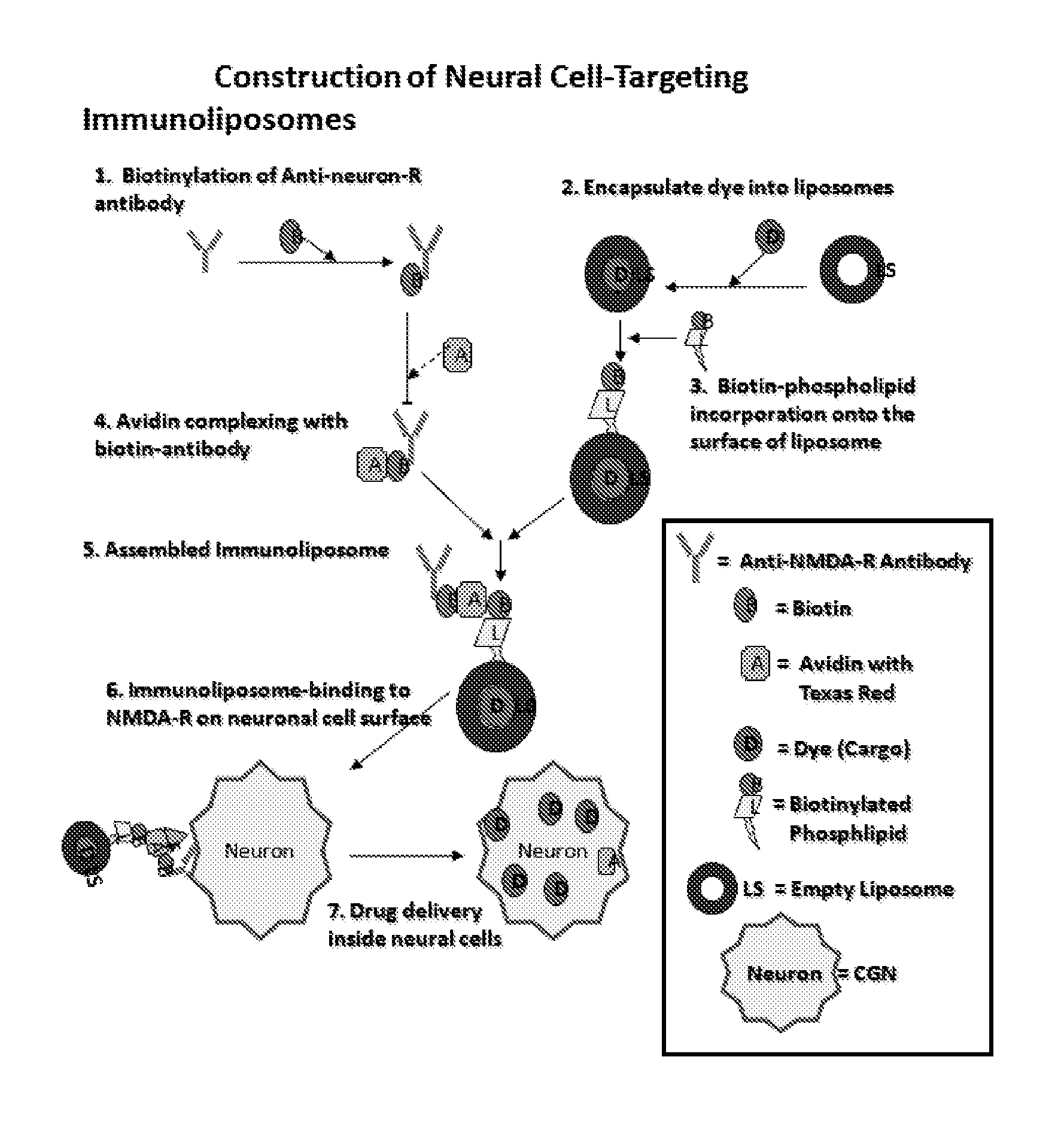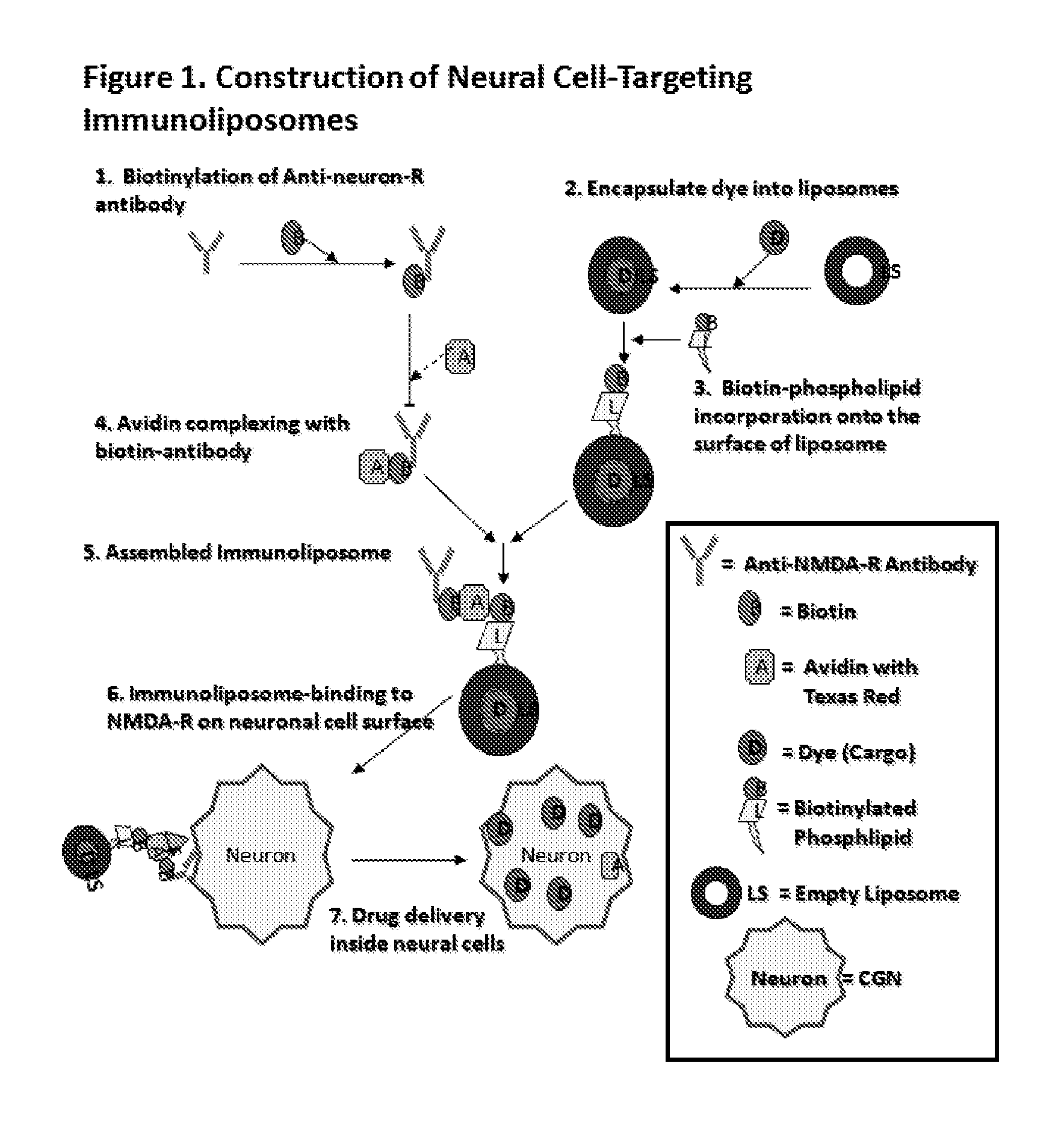Antibody bound synthetic vesicle containing molecules for deliver to central and peripheral nervous system cells
a technology of synthetic vesicle and anti-body, which is applied in the direction of chemical treatment enzyme inactivation, peptides, drug compositions, etc., can solve the problems of increased glutamate levels throughout the brain, no effective treatment has yet been developed, and the total health cost of tbi amount to roughly $35 billion annually
- Summary
- Abstract
- Description
- Claims
- Application Information
AI Technical Summary
Problems solved by technology
Method used
Image
Examples
example
Example 1
[0060]Reagents and Antibody Target Recognition: Exemplary materials and reagents used are optionally as follows. It is appreciated that other reagents are similarly operable to make and use the present invention as recognized by persons of ordinary skill in the art. Locations for obtaining such reagents are similarly known to those of skill in the art such as from biological reagent suppliers including Invitrogen Corp. (Carlsbad, Calif.), EMD Chemical, Inc., VWR Scientific (West Chester, Pa.), Santa Cruz Biotechnology (Santa Cruz, Calif.), and the like. Materials and reagents illustratively include: PBS Solution, 3.7% formalin solution, Tris-glycine electrophoresis buffer, (Invitrogen), Gel transfer buffer (Invitrogen), precast electrophoresis gels (Invitrogen), Western blot filter paper and Polyvinylidene Difluoride (PVDF) membranes (Invitrogen), methanol, Tris-buffered saline with Tween-20 (TBST) solution, (Sigma), rat primary cerebellar granular neurons, non-fat dry milk...
example 2
[0063]Antibody recognition of NMDA / Glycine receptors on the surface of CGN cells by immunocytochemistry.
[0064]Antibody targeting the surface expressed NMDA-receptor or glycine-receptor is confirmed by immunocytochemistry using CGN cells. The CGNs are grown on glass cover slips for seven days. They are then washed with phosphate buffered saline (PBS) and fixed with a 4% paraformaldehyde solution for 10 minutes at 4° C. and then blocked with a 5% normal goat serum in TBST for 30 minutes at room temperature to prevent any non-specific binding of the antibody.
[0065]The cells are divided into two experimental groups. One group is washed with cold methanol for about one minute to break open the cell membrane and make the cells permeable to antibodies. In the other group, the cell membranes are left intact so that antibodies cannot cross the cell membrane. Both groups are incubated with the primary antibodies NMDA and glycine receptor antibodies (1 / 500) overnight and then washed and incuba...
example 3
Coupling of Biotin to Antibodies
[0067]Inventive antibodies are biotinylated by methods known in the art. Briefly, the antibodies are transferred into a 1× Modification Buffer (100 mM phosphate, 150 mM NaCl, pH 7.2-7.4). A biotin solution is prepared at a concentration of 0.5 mg of biotin per 25 μL DMF (Dimethylformamide). 0.8 μL of biotin solution is added to the antibody solutions and incubated at room temperature for two hours on a rotational agitator. After incubation, the solutions are transferred to spin filters and centrifuged for 30 minutes at 12,000×g four times to filter out unbound biotin molecules. The remaining solution that had not passed through the filter is stored at 4° C. until further use.
PUM
| Property | Measurement | Unit |
|---|---|---|
| Length | aaaaa | aaaaa |
| Length | aaaaa | aaaaa |
| Length | aaaaa | aaaaa |
Abstract
Description
Claims
Application Information
 Login to View More
Login to View More - R&D
- Intellectual Property
- Life Sciences
- Materials
- Tech Scout
- Unparalleled Data Quality
- Higher Quality Content
- 60% Fewer Hallucinations
Browse by: Latest US Patents, China's latest patents, Technical Efficacy Thesaurus, Application Domain, Technology Topic, Popular Technical Reports.
© 2025 PatSnap. All rights reserved.Legal|Privacy policy|Modern Slavery Act Transparency Statement|Sitemap|About US| Contact US: help@patsnap.com



